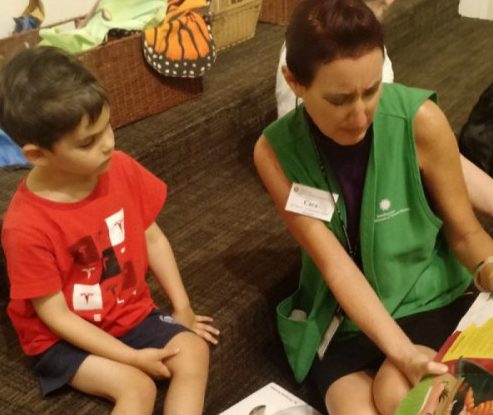
Storytime is a mainstay of early childhood programming in museums. It’s versatile, good for lots of different ages, can be relatively low prep and encourages literacy. Wins all around! However, educators have to be careful that they don’t get complacent about storytimes, they deserve just as much preparation and attention as other programming.
Below are some things to think about to keep your storytime relevant and accessible to your visitors.
- But We’ve Always…: Just because a book has been in rotation does not mean it deserves to stay. There are hundreds of new children’s books published every year about every topic under the sun. Make friends with your local children’s librarian. They are invaluable for helping you find what is age appropriate and on topic for your program. They can make sure that you are reading books with diverse characters and storylines Plus, you can help people connect with the library and they can send visitors to you!
- Set the Stage: Think about reading stories when you were little, or the stories you share with children in your life. Were you curled up in a chair or bed? Comfortably close to someone you care about? When children are read to by their primary caregiver, it is usually a personal and cozy experience. In our museums, we may expect them to sit up, on hard floors and strain to see illustrations that are far away. What can you do to make it more personal? Can you give them cushions? Encourage them to lie down? Project images on a screen so it is easy to see? Give out copies so they can follow along? Making reading personal will help them connect it with pleasant, happy times
- Practice Makes Perfect: You outline, script or rehearse your other programs, what about storytime? Make sure you practice the book, think about ways to encourage discussion and sharing observations and plan out how you will make sure everyone sees the pictures. Are there any tricky words or topics? Things that will need explaining? Does it fit with the language needs of your primary audience?
- Create Connections: Why are you sharing this story? What does it do to enhance the children’s understanding of the theme, topic or object? How will you let the children reflect and build on what they heard in the story? How can caregivers continue the learning at home? Thinking about where you are hoping your visitors take the story will make sure that the storytime isn’t just a “checkbox” with no real purpose.
Sharing a story is a fantastic way to reach out to young children, and their caregivers, and connect them with your museum. With one program you can model literacy skills for young children, expose visitors to diverse characters and new ideas, spark conversation and discussion and make your themes and topics age appropriate and accessible. However, don’t let it become another “checkbox” on your museum’s list of programs. Make sure you are as thoughtful and relevant with your storytimes as you are with any adult program.












